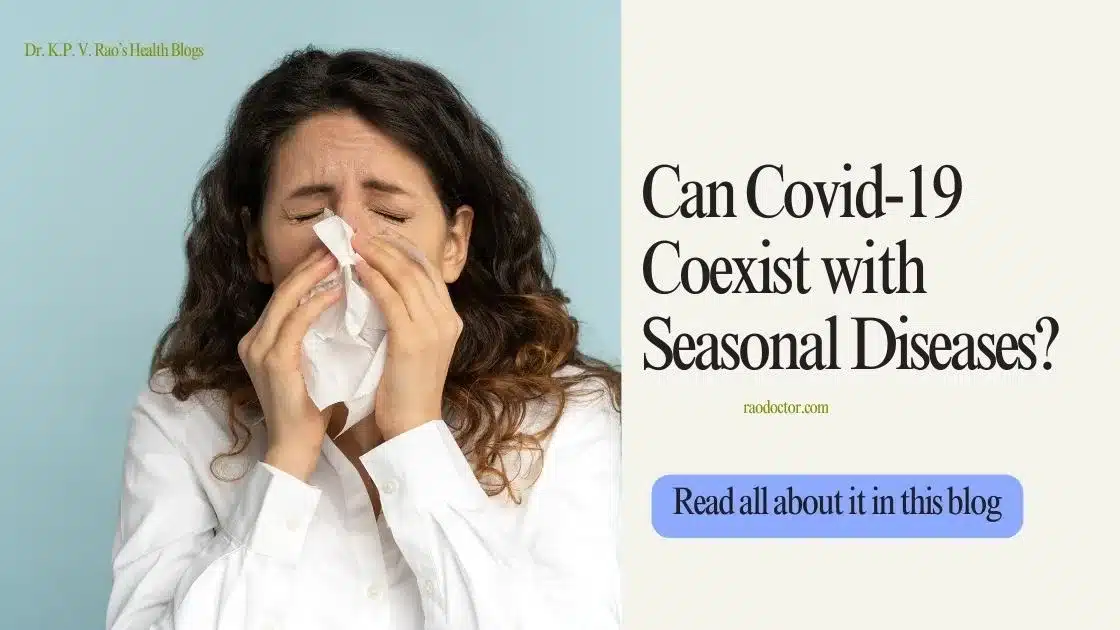Table of Contents
Introduction-Investigating the Overlapping Traits
In the aftermath of the global pandemic, the question of whether COVID-19 can coexist with seasonal diseases has become increasingly important.
As we enter the colder months, when respiratory illnesses typically thrive, it is crucial to investigate the potential overlapping traits between COVID-19 and these common seasonal ailments.
This article aims to provide an in-depth analysis of the relationship between COVID-19 and other respiratory diseases, such as the flu and the common cold.
By examining the similarities and differences in transmission, symptoms, and impact on the human body, we can gain a better understanding of how these diseases may interact and affect public health.

In this article, we will analyze the implications of coexistence of other diseases with Covid-19 and the challenges it poses for global healthcare systems through extensive research and expert insights. [I will be providing appropriate links to various articles that provides insights into this research]
We will also learn about the strategies and preventive measures that can be implemented to mitigate the impact of both COVID-19 and seasonal diseases in the coming months.
So, let us delve into this complex and timely topic to uncover the truth about the coexistence of COVID-19 with seasonal diseases.
Understanding Covid-19: Symptoms, transmission, and impact
Earlier, during the pandemic, I had written about Covid 19 and its impact on our health. If you have not read it before, you can read it here-
COVID-19, caused by the novel coronavirus SARS-CoV-2, has rapidly spread across the globe since its emergence in late 2019.
The virus primarily spreads through respiratory droplets when an infected individual coughs, sneezes, or talks.
Common symptoms of COVID-19 include
- fever,
- cough,
- shortness of breath,
- fatigue, and
- loss of taste or smell or both.
However, it is important to note that some individuals may remain asymptomatic or experience mild symptoms.
The impact of COVID-19 on the human body can vary greatly. While many individuals experience mild to moderate illness and recover without complications, others may develop severe respiratory distress, leading to hospitalization and even death.
The virus primarily targets the respiratory system, infecting the cells lining the airways and lungs.
It can cause inflammation and damage to these tissues, leading to pneumonia and acute respiratory distress syndrome (ARDS).
Additionally, COVID-19 can affect other organs, such as the heart, kidneys, and brain, causing a wide range of symptoms and complications.
Understanding seasonal diseases: Common examples and characteristics
Seasonal diseases, also known as respiratory infections, typically exhibit a cyclic pattern, with higher incidence during certain times of the year.
The picture below shows how these illnesses compare with COVID-19 and what symptoms are common with the Coronavirus disease.

The flu, caused by the influenza virus, is one of the most well-known seasonal diseases.
It spreads through respiratory droplets and shares many symptoms with COVID-19, including fever, cough, sore throat, fatigue, and body aches.
The common cold, caused by various respiratory viruses, is another prevalent seasonal disease.
It is characterized by symptoms such as a runny or stuffy nose, sneezing, sore throat, and mild cough.
Unlike COVID-19 and the flu, the common cold is usually milder and less likely to cause severe illness or complications.
The potential for coexistence: Similarities between Covid-19 and seasonal diseases
While COVID-19, the flu, and the common cold are caused by different viruses, they share some similarities in terms of transmission and symptoms.
All three diseases primarily spread through respiratory droplets, making close contact with an infected individual a common mode of transmission.
Additionally, fever, cough, and fatigue are symptoms that can be present in all three diseases, albeit with varying degrees of severity.
Some other diseases that can also coexist with Covid-19 are Malaria and Dengue. I have already published articles on these diseases previously in separate posts.
The potential for coexistence arises from the overlapping traits in terms of transmission and symptoms.
If COVID-19 and seasonal diseases are circulating simultaneously, it may become challenging to differentiate between them based on symptoms alone.
This can lead to delays in diagnosis, testing, and appropriate treatment, further straining healthcare systems already burdened by the COVID-19 pandemic.
Factors influencing coexistence: Climate, immunity, and human behavior
Several factors can influence the coexistence of COVID-19 and seasonal diseases. Climate plays a role, as respiratory viruses often exhibit seasonal patterns, with increased transmission during colder months.
The drier air and closer proximity of individuals in indoor environments during winter create favorable conditions for the spread of respiratory infections.
Immunity also plays a crucial role in determining the coexistence of diseases. Previous exposure to specific strains of the flu or the common cold can confer partial immunity, reducing the severity of subsequent infections.
In the case of COVID-19, we all have been vaccinated during the pandemic. This provides us with some immunity, but newer strains that are emerging can still be challenge towards treatment.
However, since COVID-19 is a novel virus, the population lacks pre-existing immunity, making it potentially more susceptible to severe illness.
Human behavior and preventive measures can significantly impact the coexistence of diseases.
Practices such as wearing masks, practicing good hand hygiene, maintaining physical distance, and getting vaccinated against the flu can help reduce the transmission of respiratory viruses, including COVID-19.
However, adherence to these measures varies among individuals and communities, which can influence the coexistence and spread of diseases.
Case studies: Regions with high incidence of both Covid-19 and seasonal diseases
Several regions worldwide have experienced a high incidence of both COVID-19 and seasonal diseases.
One such example is the Southern Hemisphere, where countries like Australia and South Africa faced the challenge of managing the coexistence of COVID-19 with the flu during their winter months.
These regions implemented aggressive testing, contact tracing, and public health campaigns to mitigate the impact of both diseases.
Lessons learned from these case studies can provide valuable insights into managing coexistence in other parts of the world.
Challenges and implications: Healthcare systems, testing, and vaccination
The coexistence of COVID-19 and seasonal diseases poses significant challenges for healthcare systems.
The increased demand for testing, hospitalizations, and medical resources can strain already overwhelmed healthcare infrastructures, causing problems in managing the coexistance of Covid-19 and other diseases.
Differentiating between COVID-19 and other respiratory infections becomes crucial to allocate resources effectively and provide appropriate care to patients.

Vaccination plays a vital role in mitigating the impact of both COVID-19 and seasonal diseases. The development and distribution of effective vaccines against COVID-19 have been critical in combating the pandemic.
However, the development of flu vaccines poses unique challenges due to the need for annual updates based on the circulating strains. Ensuring high vaccination rates against both COVID-19 and the flu is essential to protect individuals and reduce the burden on healthcare systems.
Prevention and mitigation strategies: Recommendations for individuals and communities
To minimize the coexistence and impact of COVID-19 and seasonal diseases, several prevention and mitigation strategies can be implemented.
Individuals should continue to follow public health guidelines, including
- wearing masks,
- practicing good hand hygiene,
- maintaining physical distance, and
- getting vaccinated against COVID-19 and the flu.
Communities can play a significant role by promoting these preventive measures, implementing targeted testing and contact tracing, and ensuring access to healthcare services for all.
Ongoing research and future considerations: Monitoring, forecasting, and preparedness
As the coexistence of COVID-19 with seasonal diseases presents ongoing challenges, continuous monitoring, forecasting, and preparedness are crucial. Surveillance systems can help identify trends and patterns, enabling early intervention and resource allocation.
Research on the interactions between COVID-19 and other respiratory viruses can provide insights into potential coexistence scenarios and guide public health strategies.
Investing in research and preparedness is essential to effectively manage future outbreaks and protect public health.
An Interesting Topic for You
Conclusion: Balancing the management of Covid-19 and seasonal diseases
In conclusion, the coexistence of COVID-19 with seasonal diseases poses unique challenges for public health.
Understanding the similarities and differences between these diseases can help guide effective prevention and management strategies.
By implementing preventive measures, promoting vaccination, and investing in research and preparedness, we can strive to minimize the impact of both COVID-19 and seasonal diseases on global health.
Final Words
Finally, I would like to say that together, we can navigate the complex landscape of respiratory infections and protect the well-being of individuals and communities worldwide.
Do share this article with your friends and family and make them aware of existance of seasonal diseases with Covid-19. Remember, the fight against Covid-19 is not yet over.
So, please play safe and stay healthy!
Adios.


![How to Match Your Biological and Your Chronological Age [Ultimate Guide] 8 Biological age vs chronological age](https://raodoctor.com/wp-content/uploads/2022/12/Add-a-subheading-11-300x300.jpg)

